sensor Peugeot 508 RXH 2014 User Guide
[x] Cancel search | Manufacturer: PEUGEOT, Model Year: 2014, Model line: 508 RXH, Model: Peugeot 508 RXH 2014Pages: 338, PDF Size: 10.81 MB
Page 141 of 338
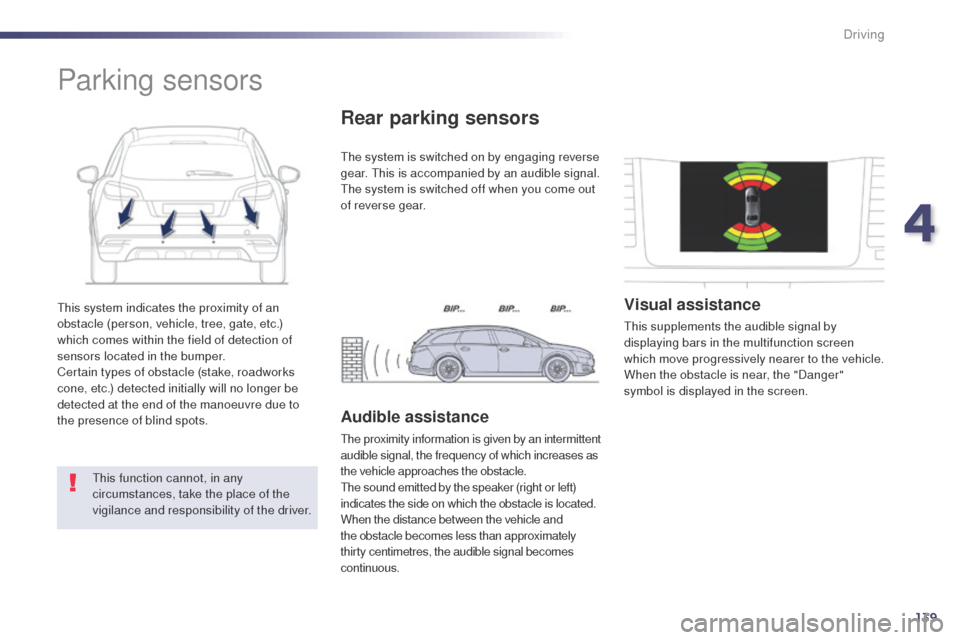
139
508RXH_en_Chap04_conduite_ed01-2014
this system indicates the proximity of an
obstacle (person, vehicle, tree, gate, etc.)
which comes within the field of detection of
sensors located in the bumper.
Certain types of obstacle (stake, roadworks
cone, etc.) detected initially will no longer be
detected at the end of the manoeuvre due to
the presence of blind spots.
Parking sensors
this function cannot, in any
circumstances, take the place of the
vigilance and responsibility of the driver.
the
system is switched on by engaging reverse
gear. t
h
is is accompanied by an audible signal.
th
e system is switched off when you come out
of reverse gear.
Rear parking sensors
Audible assistance
the proximity information is given by an intermittent
audible signal, the frequency of which increases as
the vehicle approaches the obstacle.
th
e sound emitted by the speaker (right or left)
indicates the side on which the obstacle is located.
When the distance between the vehicle and
the obstacle becomes less than approximately
thirty centimetres, the audible signal becomes
continuous.
Visual assistance
this supplements the audible signal by
displaying bars in the multifunction screen
which move progressively nearer to the vehicle.
When the obstacle is near, the "Danger"
symbol is displayed in the screen.
4
Driving
Page 142 of 338
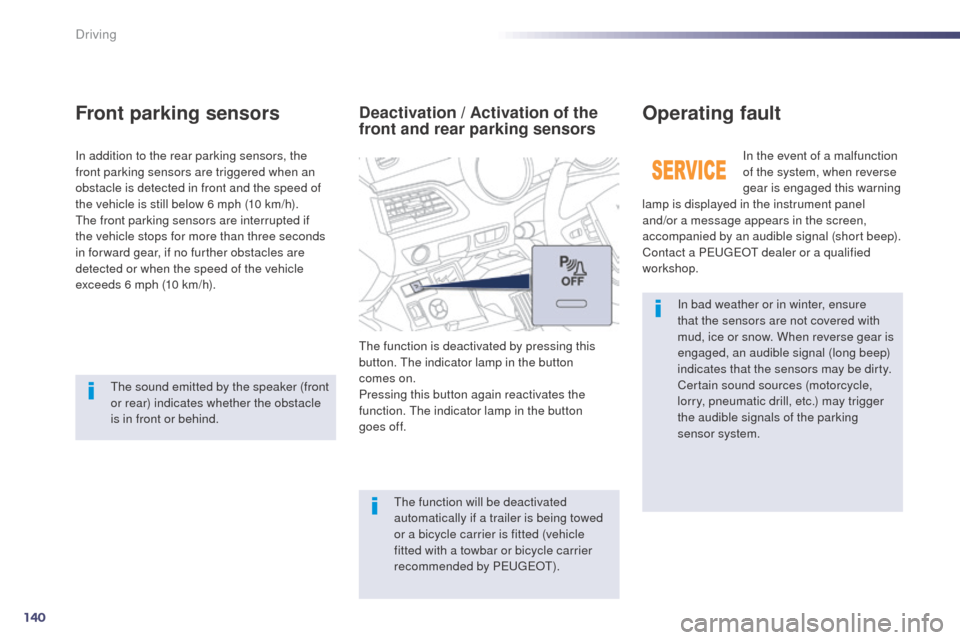
140
508RXH_en_Chap04_conduite_ed01-2014
In bad weather or in winter, ensure
that the sensors are not covered with
mud, ice or snow. When reverse gear is
engaged, an audible signal (long beep)
indicates that the sensors may be dirty.
Certain sound sources (motorcycle,
lorry, pneumatic drill, etc.) may trigger
the audible signals of the parking
sensor system.In the event of a malfunction
of the system, when reverse
gear is engaged this warning
lamp is displayed in the instrument panel
and/or a message appears in the screen,
accompanied by an audible signal (short beep).
Contact a P
e
uge
Ot
dealer or a qualified
workshop.
Operating fault
In addition to the rear parking sensors, the
front parking sensors are triggered when an
obstacle is detected in front and the speed of
the vehicle is still below 6 mph (10 km/h).
th
e front parking sensors are interrupted if
the vehicle stops for more than three seconds
in for ward gear, if no further obstacles are
detected or when the speed of the vehicle
exceeds 6 mph (10 km/h).
Front parking sensors
the function will be deactivated
automatically if a trailer is being towed
or a bicycle carrier is fitted (vehicle
fitted with a towbar or bicycle carrier
recommended by P
e
uge
Ot)
.
Deactivation / Activation of the
front and rear parking sensors
the function is deactivated by pressing this
button. th e indicator lamp in the button
comes
on.
Pressing this button again reactivates the
function.
t
h
e indicator lamp in the button
goes
off.
th
e sound emitted by the speaker (front
or rear) indicates whether the obstacle
is in front or behind.
Driving
Page 146 of 338
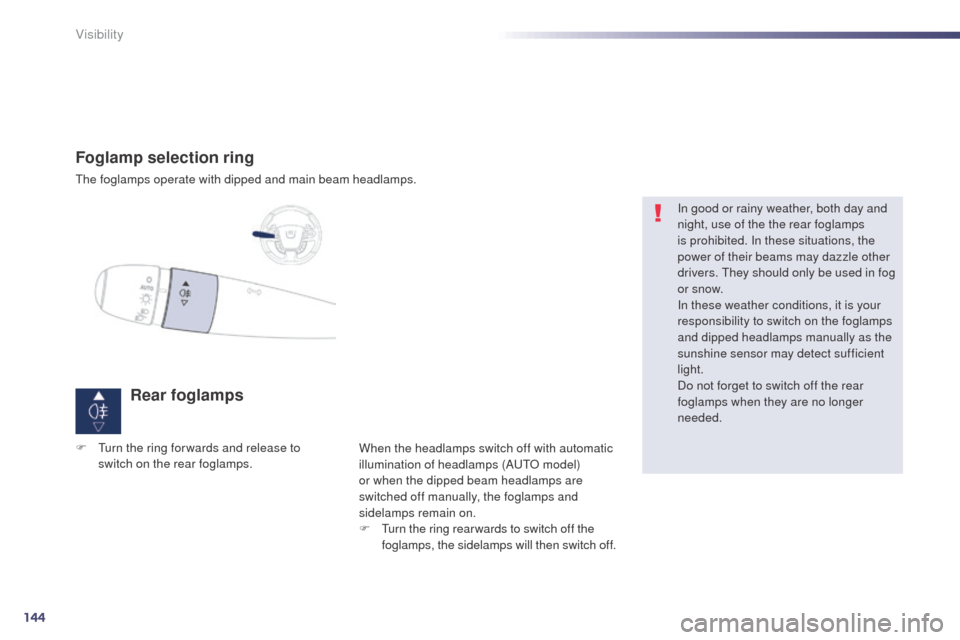
144
508RXH_en_Chap05_visibilite_ed01-2014
Foglamp selection ring
the foglamps operate with dipped and main beam headlamps.
Rear foglamps
When the headlamps switch off with automatic
illumination of headlamps (AutO m odel)
or when the dipped beam headlamps are
switched off manually, the foglamps and
sidelamps remain on.
F
t
u
rn the ring rear wards to switch off the
foglamps, the sidelamps will then switch off. In good or rainy weather, both day and
night, use of the the rear foglamps
is prohibited. In these situations, the
power of their beams may dazzle other
drivers.
t
h
ey should only be used in fog
or snow.
In these weather conditions, it is your
responsibility to switch on the foglamps
and dipped headlamps manually as the
sunshine sensor may detect sufficient
light.
Do not forget to switch off the rear
foglamps when they are no longer
needed.
F
tu
rn the ring for wards and release to
switch on the rear foglamps.
Visibility
Page 149 of 338
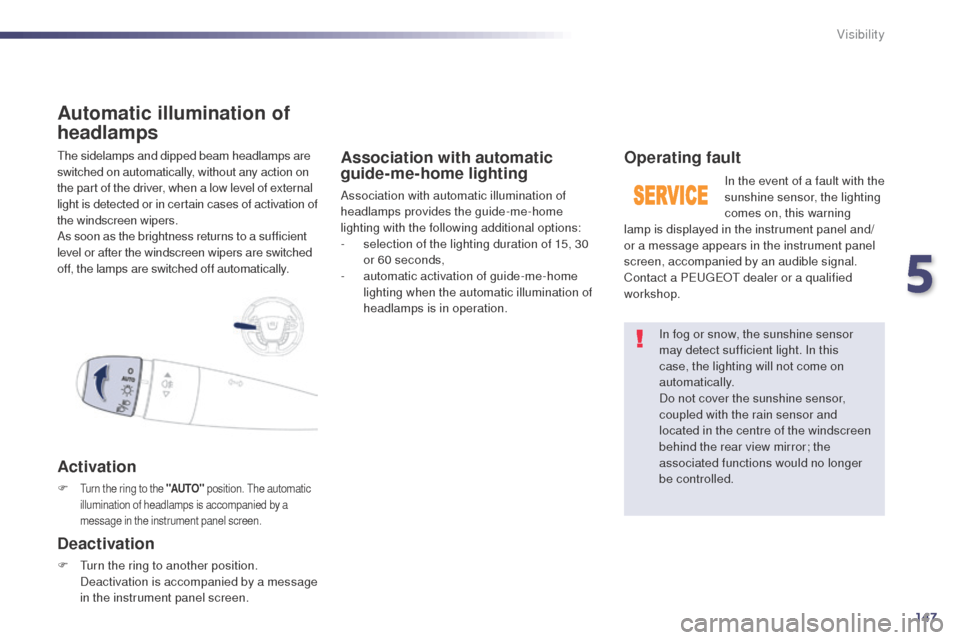
147
508RXH_en_Chap05_visibilite_ed01-2014
the sidelamps and dipped beam headlamps are
switched on automatically, without any action on
the part of the driver, when a low level of external
light is detected or in certain cases of activation of
the windscreen wipers.
As soon as the brightness returns to a sufficient
level or after the windscreen wipers are switched
off, the lamps are switched off automatically.
Automatic illumination of
headlamps
Activation
F turn the ring to the "AUTO" position. th e automatic
illumination of headlamps is accompanied by a
message in the instrument panel screen.
Deactivation
F turn the ring to another position. Deactivation is accompanied by a message
in the instrument panel screen.
Association with automatic
guide-me-home lighting
Association with automatic illumination of
headlamps provides the guide-me-home
lighting with the following additional options:
-
s
election of the lighting duration of 15, 30
or 60 seconds,
-
a
utomatic activation of guide-me-home
lighting when the automatic illumination of
headlamps is in operation.
Operating fault
In the event of a fault with the
sunshine sensor, the lighting
comes on, this warning
lamp is displayed in the instrument panel and/
or a message appears in the instrument panel
screen, accompanied by an audible signal.
Contact a P
e
uge
Ot
dealer or a qualified
workshop.
In fog or snow, the sunshine sensor
may detect sufficient light. In this
case, the lighting will not come on
automatically.
Do not cover the sunshine sensor,
coupled with the rain sensor and
located in the centre of the windscreen
behind the rear view mirror; the
associated functions would no longer
be controlled.
5
Visibility
Page 150 of 338
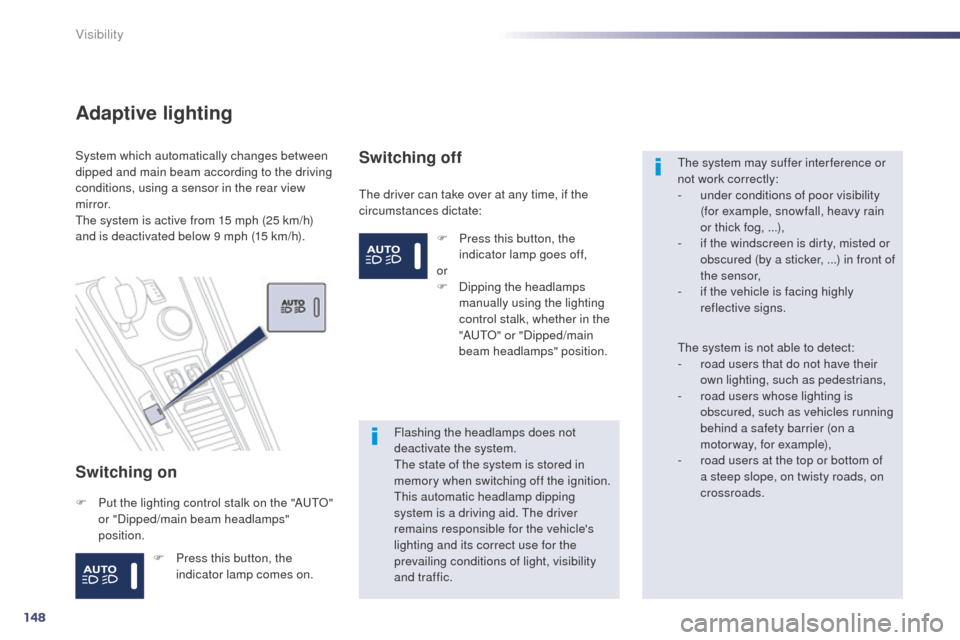
148
508RXH_en_Chap05_visibilite_ed01-2014
Adaptive lighting
Switching on
the driver can take over at any time, if the
circumstances dictate:
System which automatically changes between
dipped and main beam according to the driving
conditions, using a sensor in the rear view
m i r r o r.
th
e system is active from 15 mph (25 km/h)
and is deactivated below 9 mph (15 km/h).
F
P
ut the lighting control stalk on the "A
u
t
O
"
or "Dipped/main beam headlamps"
position.
Switching off
Flashing the headlamps does not
deactivate the system.
th
e state of the system is stored in
memory when switching off the ignition.
th
is automatic headlamp dipping
system is a driving aid.
t
h
e driver
remains responsible for the vehicle's
lighting and its correct use for the
prevailing conditions of light, visibility
and traffic.
the
system may suffer interference or
not work correctly:
-
u
nder conditions of poor visibility
(for example, snowfall, heavy rain
or thick fog, ...),
-
i
f the windscreen is dirty, misted or
obscured (by a sticker, ...) in front of
the sensor,
-
i
f the vehicle is facing highly
reflective signs.
th
e system is not able to detect:
-
r
oad users that do not have their
own lighting, such as pedestrians,
-
r
oad users whose lighting is
obscured, such as vehicles running
behind a safety barrier (on a
motorway, for example),
-
r
oad users at the top or bottom of
a steep slope, on twisty roads, on
crossroads.
F
P
ress this button, the
indicator lamp goes off,
or
F
D
ipping the headlamps
manually using the lighting
control stalk, whether in the
"A
u
t
O
" or "Dipped/main
beam headlamps" position.
F
P
ress this button, the
indicator lamp comes on.
Visibility
Page 151 of 338
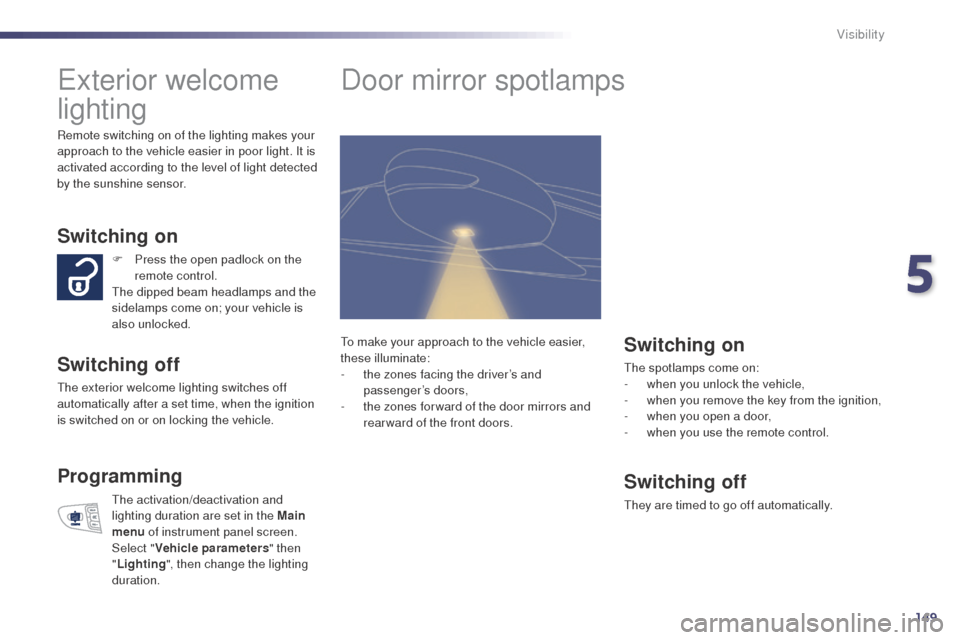
149
508RXH_en_Chap05_visibilite_ed01-2014
exterior welcome
lighting
Switching on
Switching off
the exterior welcome lighting switches off
automatically after a set time, when the ignition
is switched on or on locking the vehicle.
Programming
the activation/deactivation and
lighting duration are set in the Main
menu of instrument panel screen.
Select " Vehicle parameters " then
" Lighting ", then change the lighting
duration. F
P
ress the open padlock on the
remote control.
th
e dipped beam headlamps and the
sidelamps come on; your vehicle is
also unlocked.
Door mirror spotlamps
Switching on
the spotlamps come on:
- w hen you unlock the vehicle,
-
w
hen you remove the key from the ignition,
-
w
hen you open a door,
-
w
hen you use the remote control.
Switching off
they are timed to go off automatically.
to m
ake your approach to the vehicle easier,
these illuminate:
-
t
he zones facing the driver’s and
passenger’s doors,
-
t
he zones for ward of the door mirrors and
rear ward of the front doors.
Remote switching on of the lighting makes your
approach to the vehicle easier in poor light. It is
activated according to the level of light detected
by the sunshine sensor.
5
Visibility
Page 156 of 338
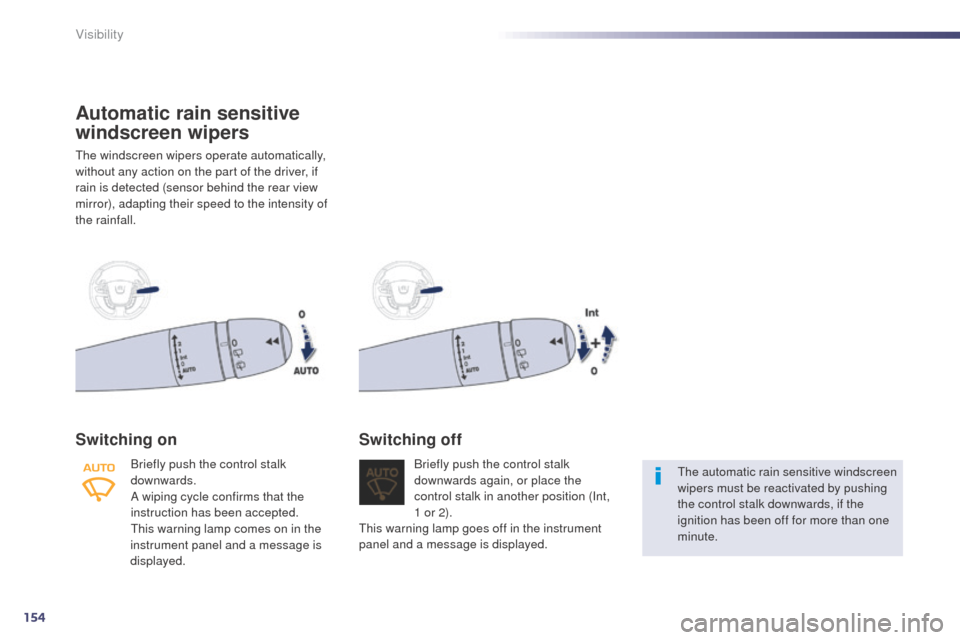
154
508RXH_en_Chap05_visibilite_ed01-2014
Automatic rain sensitive
windscreen wipers
the windscreen wipers operate automatically,
without any action on the part of the driver, if
rain is detected (sensor behind the rear view
mirror), adapting their speed to the intensity of
the rainfall.
Switching on
Briefly push the control stalk
downwards.
A wiping cycle confirms that the
instruction has been accepted.
th
is warning lamp comes on in the
instrument panel and a message is
displayed. Briefly push the control stalk
downwards again, or place the
control stalk in another position (Int,
1 or 2).
Switching off
the automatic rain sensitive windscreen
wipers must be reactivated by pushing
the control stalk downwards, if the
ignition has been off for more than one
minute.
th
is warning lamp goes off in the instrument
panel and a message is displayed.
Visibility
Page 157 of 338
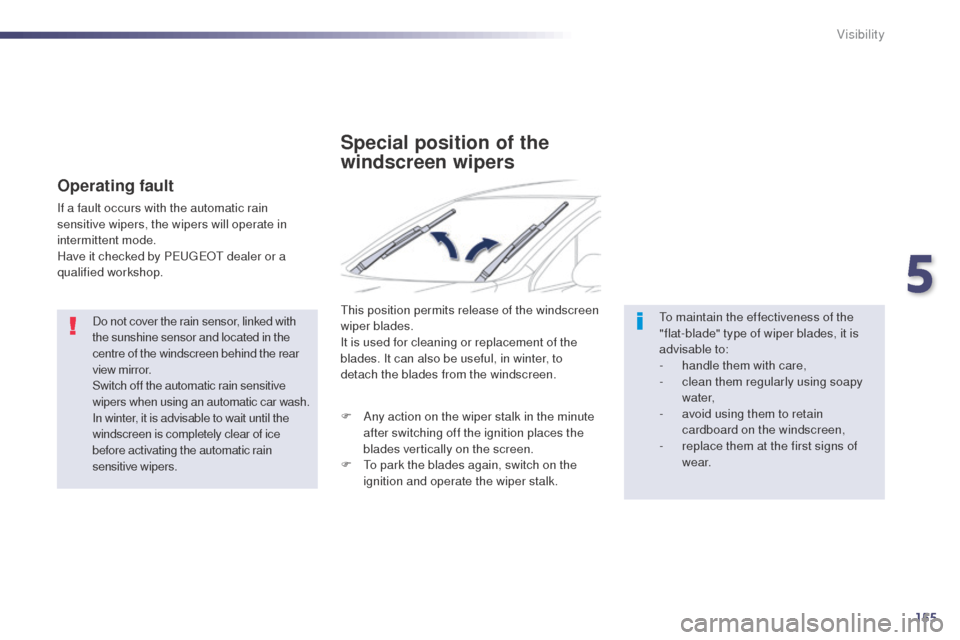
155
508RXH_en_Chap05_visibilite_ed01-2014
Do not cover the rain sensor, linked with
the sunshine sensor and located in the
centre of the windscreen behind the rear
view mirror.
Switch off the automatic rain sensitive
wipers when using an automatic car wash.
In winter, it is advisable to wait until the
windscreen is completely clear of ice
before activating the automatic rain
sensitive wipers.
Operating fault
If a fault occurs with the automatic rain
sensitive wipers, the wipers will operate in
intermittent mode.
Have it checked by P
e
uge
Ot
dealer or a
qualified workshop.
Special position of the
windscreen wipers
this position permits release of the windscreen
wiper blades.
It is used for cleaning or replacement of the
blades. It can also be useful, in winter, to
detach the blades from the windscreen.to m aintain the effectiveness of the
"flat-blade" type of wiper blades, it is
advisable to:
-
h
andle them with care,
-
c
lean them regularly using soapy
water,
-
a
void using them to retain
cardboard on the windscreen,
-
r
eplace them at the first signs of
w e a r.
F
A
ny action on the wiper stalk in the minute
after switching off the ignition places the
blades vertically on the screen.
F
t
o p
ark the blades again, switch on the
ignition and operate the wiper stalk.
5
Visibility
Page 177 of 338
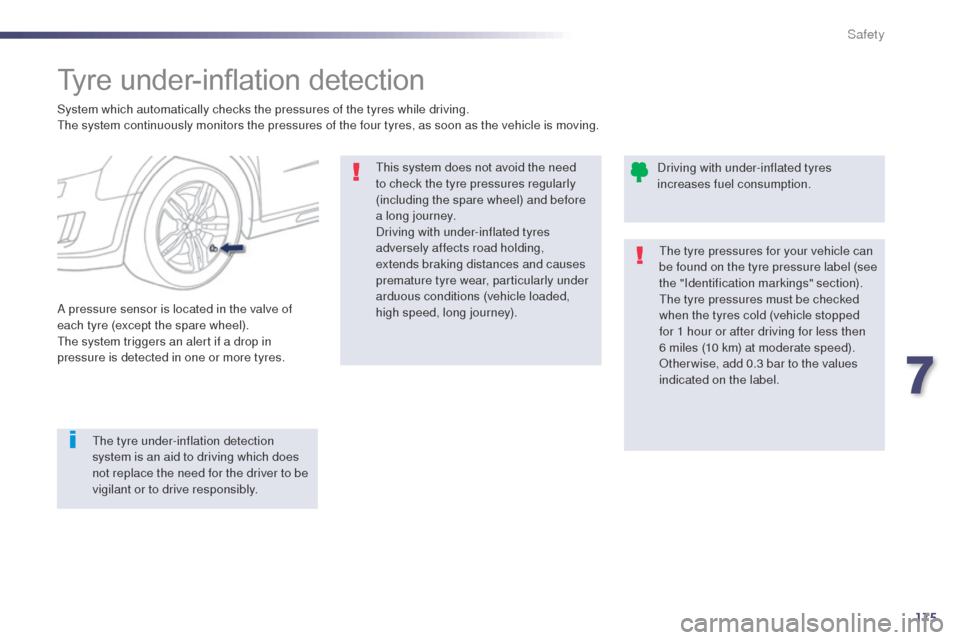
175
508RXH_en_Chap07_securite_ed01-2014
Tyre under-inflation detection
System which automatically checks the pressures of the tyres while driving.the system continuously monitors the pressures of the four tyres, as soon as the vehicle is moving.
th
e tyre under-inflation detection
system is an aid to driving which does
not replace the need for the driver to be
vigilant or to drive responsibly.
A pressure sensor is located in the valve of
each tyre (except the spare wheel).
th
e system triggers an alert if a drop in
pressure is detected in one or more tyres.
th
is system does not avoid the need
to check the tyre pressures regularly
(including the spare wheel) and before
a long journey.
Driving with under-inflated tyres
adversely affects road holding,
extends braking distances and causes
premature tyre wear, particularly under
arduous conditions (vehicle loaded,
high speed, long journey). Driving with under-inflated tyres
increases fuel consumption.
th
e tyre pressures for your vehicle can
be found on the tyre pressure label (see
the "Identification markings" section).
th
e tyre pressures must be checked
when the tyres cold (vehicle stopped
for 1 hour or after driving for less then
6 miles (10 km) at moderate speed).
Other wise, add 0.3 bar to the values
indicated on the label.
7
Safety
Page 178 of 338
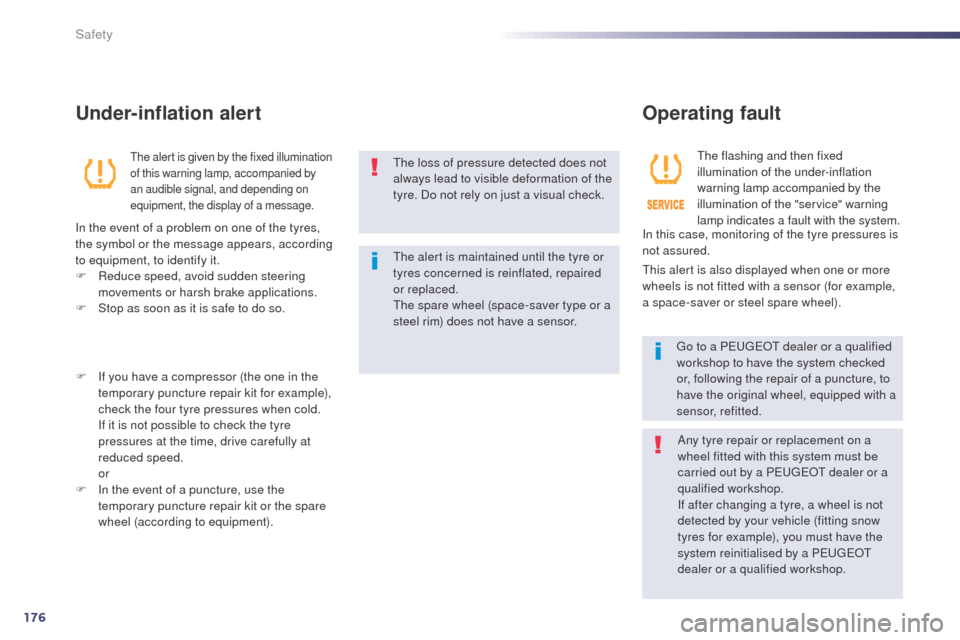
176
508RXH_en_Chap07_securite_ed01-2014
the loss of pressure detected does not
always lead to visible deformation of the
tyre. Do not rely on just a visual check.
th
e alert is maintained until the tyre or
tyres concerned is reinflated, repaired
or replaced.
th
e spare wheel (space-saver type or a
steel rim) does not have a sensor.
Operating fault
the flashing and then fixed
illumination of the under-inflation
warning lamp accompanied by the
illumination of the "service" warning
lamp indicates a fault with the system.
th
is alert is also displayed when one or more
wheels is not fitted with a sensor (for example,
a space-saver or steel spare wheel).
go t
o a P
e
uge
Ot
dealer or a qualified
workshop
to have the system checked
or, following the repair of a puncture, to
have the original wheel, equipped with a
sensor, refitted.
Under-inflation alert
the alert is given by the fixed illumination
of this warning lamp, accompanied by
an audible signal, and depending on
equipment, the display of a message.
In the event of a problem on one of the tyres,
the symbol or the message appears, according
to equipment, to identify it.
F
R
educe speed, avoid sudden steering
movements or harsh brake applications.
F
S
top as soon as it is safe to do so.
F
I
f you have a compressor (the one in the
temporary puncture repair kit for example),
check the four tyre pressures when cold.
I
f it is not possible to check the tyre
pressures at the time, drive carefully at
reduced speed.
or
F
I
n the event of a puncture, use the
temporary puncture repair kit or the spare
wheel (according to equipment). Any tyre repair or replacement on a
wheel fitted with this system must be
carried out by a P
e
uge
Ot
dealer or a
qualified workshop.
If after changing a tyre, a wheel is not
detected by your vehicle (fitting snow
tyres for example), you must have the
system reinitialised by a P
e
uge
Ot
dealer or a qualified workshop.
In this case, monitoring of the tyre pressures is
not assured.
Safety